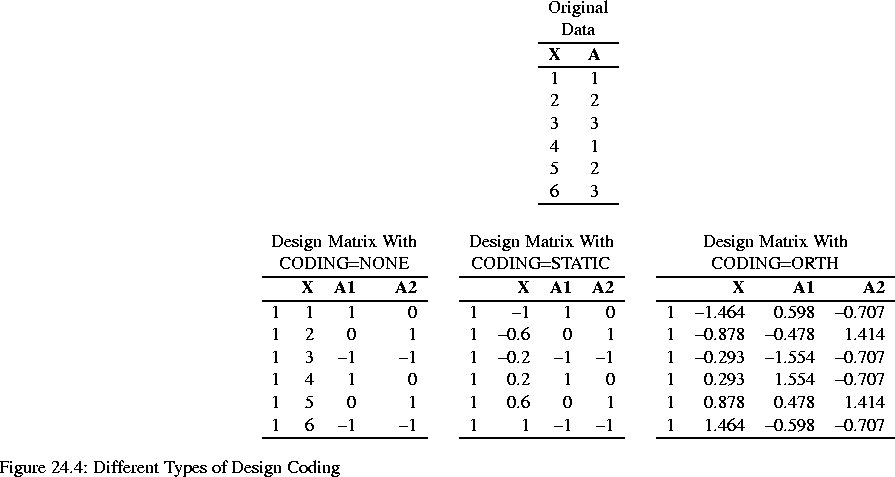| Details of the OPTEX Procedure |
Design Coding
The way the independent effects of the model are interpreted to generate
a linear model is called coding. The OPTEX procedure provides for
different types of coding. For D-optimality, the type of coding affects
only the absolute value of the computed efficiency criteria, not the
relative values for two different designs. Thus, different codings do not
affect the choice of D-optimal design. In this section, the details and
ramifications of the different types of coding are discussed.
Coding the points in a design involves selecting linearly independent
columns corresponding to each model term, turning particular values of the
factors into a row vector x. The OPTEX procedure requires
a non-singular coding for the design matrix. Because of this,
any two coding schemes are related by a non-singular transformation.
The default coding for the design points is as follows:
- Unless you specify CODING=NONE (or NOCODE) in the PROC OPTEX
statement, continuous variables are centered and scaled so that
their maximum and minimum values are 1 and -1,
respectively.
- The k-1 columns corresponding to the main effect of a
classification variable A are computed as follows: For a
design point with A at its i th level, for
 , the columns of the design matrix associated with A are all 0
except for the i th column, which is 1. When A is at its
k th level, all k-1 columns associated with A are -1.
Thus, if
, the columns of the design matrix associated with A are all 0
except for the i th column, which is 1. When A is at its
k th level, all k-1 columns associated with A are -1.
Thus, if  denotes the expected response at the i th
level of A, the k-1 columns yield estimates of
denotes the expected response at the i th
level of A, the k-1 columns yield estimates of
 .
. - Columns for crossed effects are computed by taking the
horizontal direct product of columns corresponding to the
constituent effects.
This coding corresponds to modeling without over-parameterization,
using the same method as the CATMOD procedure in SAS/STAT software. This is
different from the method used by the GLM procedure, which uses an
over-parameterized model.
Orthogonal Coding
If you specify CODING=ORTH or CODING=ORTHCAN, the points are first coded
as described in the previous section and then recoded so that
XC'XC = NC·I, where XC is the design matrix for the candidate
points, NC is the number of candidates, and I is the identity matrix.
This is required in order
for the D- and A-efficiency measures to make sense. For the option
CODING=ORTHCAN, this recoding is accomplished by computing a square matrix
R such that XC'XC = R'R and then transforming each row vector
x as

If you specify CODING=ORTH, the recoding is done in a similar fashion,
except that the matrix R is computed according to
XC'XC + XA'XA + XI'XI = R'R, where XA and XI are the
design matrices (coded as described in the previous section.)
Thus, these two orthogonal coding options only differ when there is an
AUGMENT= or INITDESIGN= data set ; the option
CODING=ORTH includes points from these data sets in computing the
orthogonal coding, while the option CODING=ORTHCAN uses only the
candidates themselves.
Example of Coding
For example, consider a main effect model with one continuous variable X
and one three-level classification variable A. The results of the
various coding options are shown in Figure 24.4.

The first column in each design matrix is an all-ones vector corresponding
to the intercept, the next column corresponds to the linear effect of X,
and the last two columns correspond to the two degrees of freedom for the
main effect of A.
General Recommendations
Coding does not affect the relative ordering of designs by D-efficiency,
and the same is true for G-efficiency and the average standard error of
prediction.
This is easy to see for the latter two measures, which are based on the
variance of prediction, since how accurately a point is predicted should not
be affected by how the independent variables are coded. For D-optimality,
note again that coding corresponds to multiplying the design matrix on the
right by some non-singular transformation A, which changes the determinant
of the information matrix as follows:

Thus, recoding simply multiplies the D-criterion by a constant that
is the same for all designs. Note, however, that A-optimality is
not invariant to coding.
Orthogonal coding will usually be the right one; it is not the
default because it depends on the candidate set. Note, however, that
for the distance-based criteria, if the distance between two points
should be computed in terms of the actual values of the model variables
instead of centered and scaled values, then you should specify CODING=NONE
or NOCODE. The NOCODE option is also usually appropriate when the NOINT
option is specified.
Copyright © 1999 by SAS Institute Inc., Cary, NC, USA. All rights reserved.


